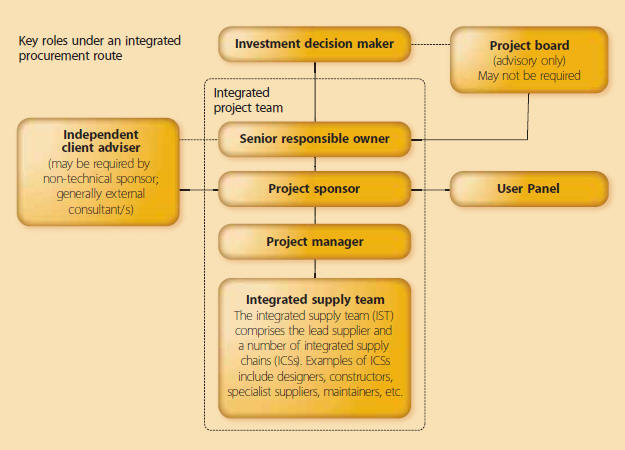Investment decision maker for building design and construction
The government recommend that publicly-funded projects follow either private finance initiative, prime contracting or design and build procurement routes. These routes as described by the government are unusual in that they propose appointing an integrated supply team (designers, contractors, suppliers and facilities managers) after the project brief has been prepared, before design commences.
This means that the main decision to invest i.e. to appoint the integrated supply team, (gateway 3 of the OGC gateway review process) takes place before concept design or detailed design are prepared.
The investment decision maker (IDM) is the individual from within the client organisation that decides whether or not the proposed investment in the project should be made and then oversees senior management as they deliver the project. The role might be undertaken by an accounting officer or chief executive, or by a group such as a management board. The role might be at ministerial level if the project is significant.
The investment decision maker should assess the project at key points (gateways) in its development (See OGC Gateway Review for Programmes & Projects), and should not allow the project to proceed beyond these gateways unless they are satisfied that sufficient analysis has been carried out by the project team, with the appropriate advise, and that the analysis provides adequate justification for continued investment.
The investment decision maker considers the success of the project in relation to the overall business, and so the final decision to make the investment is made in the context of business drivers and benefits.
The OGC guidance explains when these gateways should take place and describes in detail the issues that should be considered at those gateways. At each gateway, the investment decision commissions a confidential, independent peer review (gateway review) and then decides whether or not to give approval for the project to proceed.
The position of the investment decision maker in relation to the rest of the project team is illustrated in OGC guidance as shown below.
Image reproduced courtesy of OGC.
NB The Office of Government Commerce (OGC) has now been absorbed into the Efficiency and Reform Group (ERG) within the Cabinet Office. OGC guidance has been archived, however, it is cited in the Government Construction Strategy and the Common Minimum Standards, and links are provided to OGC documents from government websites such as the Major Projects Authority. The OGC gateway review process still provides one of the best and most comprehensive sets of guidance for public projects. It is for this reason that the project plan for public projects within Designing Buildings Wiki follows the OGC gateway review process.
[edit] Related articles on Designing Buildings Wiki
Featured articles and news
The UK's Modern Industrial Strategy: A 10 year plan
Previous consultation criticism, current key elements and general support with some persisting reservations.
Building Safety Regulator reforms
New roles, new staff and a new fast track service pave the way for a single construction regulator.
Architectural Technologist CPDs and Communications
CIAT CPD… and how you can do it!
Cooling centres and cool spaces
Managing extreme heat in cities by directing the public to places for heat stress relief and water sources.
Winter gardens: A brief history and warm variations
Extending the season with glass in different forms and terms.
Restoring Great Yarmouth's Winter Gardens
Transforming one of the least sustainable constructions imaginable.
Construction Skills Mission Board launch sector drive
Newly formed government and industry collaboration set strategy for recruiting an additional 100,000 construction workers a year.
New Architects Code comes into effect in September 2025
ARB Architects Code of Conduct and Practice available with ongoing consultation regarding guidance.
Welsh Skills Body (Medr) launches ambitious plan
The new skills body brings together funding and regulation of tertiary education and research for the devolved nation.
Paul Gandy FCIOB announced as next CIOB President
Former Tilbury Douglas CEO takes helm.
UK Infrastructure: A 10 Year Strategy. In brief with reactions
With the National Infrastructure and Service Transformation Authority (NISTA).
Ebenezer Howard: inventor of the garden city. Book review.
The Grenfell Tower fire, eight years on
A time to pause and reflect as Dubai tower block fire reported just before anniversary.
Airtightness Topic Guide BSRIA TG 27/2025
Explaining the basics of airtightness, what it is, why it's important, when it's required and how it's carried out.
Construction contract awards hit lowest point of 2025
Plummeting for second consecutive month, intensifying concerns for housing and infrastructure goals.
Understanding Mental Health in the Built Environment 2025
Examining the state of mental health in construction, shedding light on levels of stress, anxiety and depression.






















